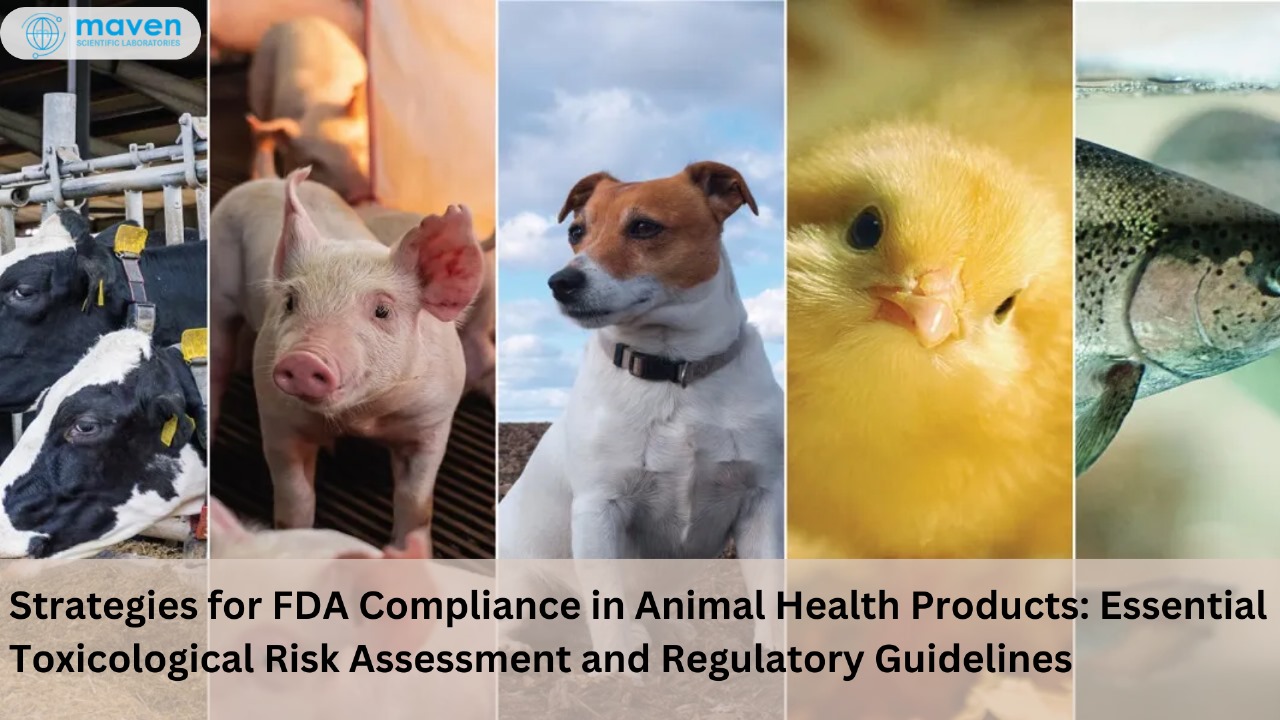
Strategies For FDA Compliance In Animal Health Products: Essential Toxicological Risk Assessment And Regulatory Guidelines
Receiving an FDA warning for marketing unapproved new animal drugs can be challenging and potentially disruptive. Understanding the regulatory landscape and taking swift corrective action is crucial to ensuring the success and compliance of your animal health products. Here’s an in-depth look at how companies can address these concerns and how Maven can provide expert support.
Regulatory Guidelines for Animal Health Products
The FDA has stringent regulatory guidelines that govern the marketing and distribution of cell and tissue-based regenerative therapy products for animals. Products marketed with claims of treating, diagnosing, or preventing diseases are classified as new animal drugs under the Federal Food, Drug, and Cosmetic Act (FD&C Act). To comply with these regulations, companies must meet specific criteria, including:
Approval or Conditional Approval New animal drugs require an approved New Animal Drug Application (NADA) or a conditionally approved application. The approval process involves demonstrating the product's safety and efficacy through rigorous scientific studies.
Index Listing For certain minor species or uses, products can be indexed under specific FDA guidelines, making them eligible for marketing without full approval. This pathway is available for products that meet stringent safety and effectiveness criteria.
Clear and Accurate Labelling Claims must be supported by scientific evidence and must not imply therapeutic benefits without FDA approval. Marketing language must be reviewed to ensure compliance with FDA regulations.
Importance of Toxicological Risk Assessments
Conducting a toxicological risk assessment is a crucial step in the regulatory process for any product intended for use in animals. Toxicological assessments help to establish the safety profile of a product by evaluating potential adverse effects. These assessments involve:
- Identifying Potential Hazards: Analysing the active ingredients or components of a product to determine if they pose any toxic risk to animals.
- Dose-Response Analysis: Evaluating the relationship between the dose and the observed effect to establish safe exposure levels.
- Exposure Assessment: Estimating the likelihood and level of exposure animals will have to the product under normal usage conditions.
- Risk Characterization: Integrating the data from hazard identification, dose-response analysis, and exposure assessment to provide a comprehensive risk profile.
Types of Documentation to Overcome FDA Compliance Issues
To respond effectively to an FDA warning, your company may need to prepare several types of documentation and support materials:
New Animal Drug Application (NADA) Submissions A complete NADA includes data on the product’s safety, efficacy, manufacturing processes, labelling, and environmental impact. This documentation provides the necessary scientific evidence to support your product’s approval.
Clinical Safety and Efficacy Studies These reports compile findings from well-designed clinical studies that demonstrate the product’s effectiveness and safety in treating or mitigating disease conditions in animals.
Toxicological Risk Assessment Files Detailed toxicology assessments present the safety evaluation of your product, addressing any potential risks to animal health. These evaluations are crucial in proving that the product poses no significant safety concerns.
Regulatory Compliance Summaries These summaries outline your corrective actions, including modifications to marketing materials, updated product claims, and measures taken to comply with FDA regulations. Providing documentation of these changes is vital in addressing the FDA’s concerns.
Post-Market Surveillance Plans A plan that outlines how your company will monitor the safety and efficacy of the product after it has entered the market. This may include adverse event reporting and ongoing safety evaluations.
How Maven Can Help
At Maven, we specialize in helping companies navigate complex regulatory challenges and achieve compliance with FDA requirements. Our team of experts offers a comprehensive suite of services, including:
- Regulatory Consulting: We provide guidance on how to align your product marketing and claims with FDA regulations. Our experts can assist in preparing NADA submissions and ensuring all documentation is compliant.
- Toxicological Risk Assessments: Our team conducts in-depth toxicological evaluations to determine the safety of your products. We prepare detailed files that support your regulatory submissions and demonstrate the product’s risk profile.
- Scientific Study Design and Support: We can design clinical and toxicological studies that meet FDA standards, helping you generate the data needed for approval or conditional approval.
- Labelling and Marketing Review: We review your product labelling and promotional materials to ensure they adhere to regulatory guidelines, minimizing the risk of future warnings.
- Ongoing Compliance Monitoring: Our services extend beyond initial approval, offering continuous support for post-market surveillance and updates on evolving regulatory standards.
Conclusion
Overcoming FDA warnings for unapproved new animal drugs requires a strategic, evidence-based approach. By following regulatory guidelines, conducting thorough toxicological risk assessments, and preparing comprehensive documentation, your company can address these challenges effectively. Maven is here to support you every step of the way, providing the expertise needed to ensure compliance and the continued success of your animal health products.
Reach out to Maven today to learn how we can assist in safeguarding your company from regulatory setbacks and positioning your products for long-term success.







